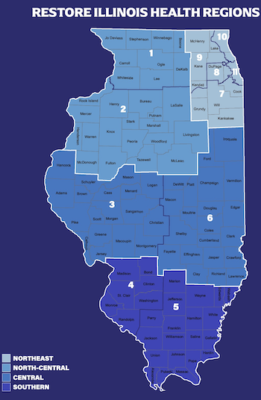Governor J.B. Pritzker announced yesterday a regionalized plan to reopen the state. Pritzker said he would be using the suggestion of Senate Republican Leader Bill Brady in using the states 11 EMS zones to create his 5-phase plan. “I want to introduce you to our framework moving forward. “Restore Illinois” is a public health to safely reintroduce the parts of our lives that have been put on hold in our fight against COVID-19. Science and data are our overarching guardrails on how we move forward. Within those guardrails, I’ve listened to people from across the state and the nation about what can be done to put us on a path toward normalcy. Many of those ideas are incorporated into the executive order that I issued last week and many more are in the plan that I present to you today. Many members of the General Assembly proposed a regional approach to reopening. Senate Republican leader Bill Brady and his caucus suggested our EMS regions to shape a reopening plan. Indeed that’s the structure of the plan that I am revealing to you today.”
Pritzker says that the phases will be guided by health metrics to either move a region forward or backward in the reopening. The five phases are as follows:
Phase 1 – Rapid Spread: The rate of infection among those tested and the number of patients admitted to the hospital is high or rapidly increasing. Strict stay at home and social distancing guidelines are put in place and only essential businesses remain open. Every region has experienced this phase once already and could return to it if mitigation efforts are unsuccessful.
Phase 2 – Flattening: The rate of infection among those tested and the number of patients admitted to the hospital beds and ICU beds increases at an ever slower rate, moving toward a flat and even a downward trajectory. Non-essential retail stores reopen for curb-side pickup and delivery. Illinoisans are directed to wear a face covering when outside the home, and can begin enjoying additional outdoor activities like golf, boating and fishing while practicing social distancing. To varying degrees, every region is experiencing flattening as of early May.
Phase 3 – Recovery: The rate of infection among those tested, the number of patients admitted to the hospital, and the number of patients needing ICU beds is stable or declining. Manufacturing, offices, retail, barbershops and salons can reopen to the public with capacity and other limits and safety precautions. All gatherings limited to 10 or fewer people are allowed. Face coverings and social distancing are the norm.
Phase 4 – Revitalization: The rate of infection among those tested and the number of patients admitted to the hospital continues to decline. All gatherings of up to 50 people are allowed, restaurants and bars reopen, travel resumes, child care and schools reopen under guidance from the IDPH. Face coverings and social distancing are the norm.
Phase 5 – Illinois Restored: With a vaccine or highly effective treatment widely available or the elimination of any new cases over a sustained period, the economy fully reopens with safety precautions continuing. Conventions, festivals and large events are permitted, and all businesses, schools, and places of recreation can open with new safety guidance and procedures in place reflecting the lessons learned during the COVID-19 pandemic.
The five-phase plan is based on regional healthcare availability and recognizes the distinct impact COVID-19 has had on different regions of the state as well as regional variations in hospital capacity. The 11 Emergency Medical Services Regions have traditionally guided IDPH’s statewide public health work and communication. For the purposes of the “Restore Illinois” plan, from those 11 zones, four health regions have been established, each given the ability to independently move through the 5-phase approach: Northeast Illinois; North-Central Illinois; Central Illinois; and Southern Illinois.
Pritzker says a return to normal isn’t possible: “I know that we all have a passionate desire to return to a sense of normalcy that we felt before the world knew about COVID-19. Here’s the truth, and I don’t like it any more than you: Until we have a vaccine or an effective treatment or enough widespread immunity that new cases fail to materialize, the option of returning to normalcy doesn’t exist. That means we have to figure out to live with COVID-19 until it can be vanquished, and to do so in a way that best supports our residents’ health and our healthcare systems and saves the most lives.”
Pritzker says IDPH will be in charge of monitoring the data to move the regions through each phase: “First, a region must be at or under a 20% test positivity rate and increasing by no more than 10 percentage points over a 14 day period, and a region must have either not had an overall increase or must have maintained overall stability in hospital admissions for COVID-like illness in the last 28 days, and a region must maintain the availability of a surge threshold of 14% availability of ICU beds of medical and surgery beds and ventilators. Because May 1 marked the beginning of phase two in which we loosened and modified a number of mitigations, that is the first day for the 14 and 28 day measurement periods to begin, meaning that the earliest that a region can move to phase three is May 29. Changes to mitigation strategies in each phase will impact the data in each phase. So the assessment period begins when each new phase begins. IDPH will be tracking each of the four regions on these metrics, and we’ll make that available data available online to you every day, so that the public can track it to. Importantly, just as public health indicators will tell us when to move forward at any time. They could also signal that we need to move backward.”
The reopening announcement came on the deadliest day of the COVID-19 pandemic so far with a new high of 176 deaths over the last 24 hours. One of the deaths was a woman in her 40s in Macoupin County, the first death attributed to the death in the county. The Illinois Department of Public Health also announced an additional 2,122 new positive tests across 97 counties in the state.




